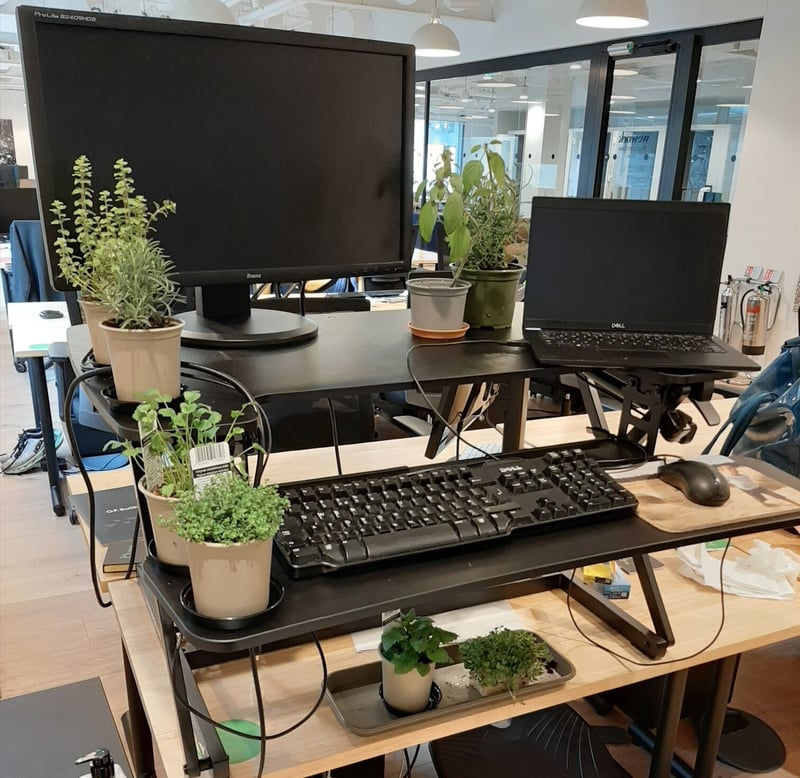It’s Monday morning. The coffee is brewing and you’re in front of your computer preparing to tackle...
How to Reduce Your Carbon Footprint by Working from Home
Home offices have become the modern workplace. More and more people start their day with a telecommute and have grown used to working from their own desks. But what many don’t realize is that working from home can have a huge benefit, not just on you as an employee, but also on the planet we live on. More and more people are questioning how to reduce their carbon footprint and how to make the way we live a little more environmentally friendly. Yet the environmental benefits of remote working are often overlooked.
You may not be able to see it on a day-to-day basis, but there are major changes constantly happening around us. The air quality has been getting worse and the climate is rapidly changing.
With how much we rely on technology these days, remote work can have a huge impact on our planet. So, it might sound mega dramatic, but if you want to change the world, it’s worth considering how your daily work routine will affect it.
Does remote working reduce your carbon footprint?
Yes, remote work does reduce your carbon footprint. Telecommuting has a number of environmental benefits. It reduces greenhouse gas emissions, fossil fuel consumption, air pollution, and paper and plastic waste.
These benefits are also cumulative. For example, if 100 employees in a company work remotely for one day a week, this would reduce 100 times more greenhouse gas emissions than if just one person did.
The best part is that, with only a few simple changes to how you work at home, you can boost the environmental benefits of remote working even further. So, here are a few ways you can reduce your carbon footprint by working from home.
No commute = fewer emissions
Possibly the most popular benefit of working remotely is no commute. People don’t miss the hour-long drive at 7am, or sitting in a traffic jam on a Friday evening when they really want to be on the sofa with a glass of wine. And the good news is, the lack of a commute has a positively significant impact on the environment.
Cars emit a number of pollutants that are bad for our planet. These include carbon dioxide and other dangerous fumes like nitrogen oxide, sulfur dioxide, or particulate matter (tiny bits of dust or soot).

But no employees on the road = no emissions from cars. Let’s put that into perspective.
The average commute time in the US is roughly 27 minutes and around 15 miles – it’s also getting longer every year with more and more people traveling further to reach the office. The average vehicle emits about 404 grams of CO2 per mile.
If 100 people drive 30 miles to work and back each day, that’s 80,800 grams of carbon dioxide emissions released into the atmosphere. In just one day. From just one company.
If you multiply this across the working population of the US, currently 157.54 million people, that would be 63,646,160,000 grams of CO2 released each day. Reducing this number would have a phenomenal impact on our planet.
We’ll use fewer fossil fuels
Remote work also has a massive impact on fossil fuel consumption around the globe. The impact of fossil fuels on the environment is extensive – burning fossil fuels releases large amounts of carbon dioxide into our atmosphere, contributing to climate change and global warming.
And we use fossil fuels for a lot of everyday things that we take for granted – heat, electricity, and transportation. In fact, the majority of the components of petrol are made up of fossil fuels.
So how does remote working affect fossil fuels?
Remote work reduces the need for petrol. In 2020, Americans used about 123 billion gallons of fuel, which is about 337 million gallons per day. Just imagine how many of those gallons were used on the daily commute? And imagine how many fossil fuels could be saved if all those computers worked from home.
That’s an incredible environmental impact from just reducing how often people drive to work.
It is also worth noting that many employees are choosing to commute via public transport as well – which has its own benefits. But even with this being said, public transport still has emissions and uses fuels.
So, if you’re wondering how to reduce your carbon footprint, remote work still wins.
Remote work means less paper use
Remote work means remote meetings. This usually means virtual notes instead of print-outs and online presentations instead of pamphlets and paper worksheets.
Less paper usage is a huge benefit of remote work and it can seriously impact the environment for the better. Reducing your paper usage prevents trees from being cut down, which saves lots of energy. It also reduces the amount of waste your office produces and how much is sent to landfill sites.
Plus, it saves storage space. The amount of office space required to store all those files, meeting notes, or other materials goes down tremendously when they are stored digitally. Employees have access to virtually everything that’s going on at any time – without having stacks and stacks of papers.
There is less need for printers as well (which use a lot more electricity than computers) because documents get transferred electronically. Less paper means fewer trees being cut down and less waste from paper – a definite environmental win.
The global power consumption will go down
When we work in the office, we use a lot of energy. Electricity powers computers, heaters, aircon, lighting, coffee machines, printers, and plenty more office equipment.

A study found that due to the pandemic and peak lockdown meaning that the majority of employees had to work from home, power usage dropped significantly. During June 2020, electricity usage around the globe was 10% below the levels used in the same month in 2019 in most countries.
Although this is slowly creeping back to normal as more people return to the office, this is still a huge saving and shows just how much energy we could preserve if companies became fully remote businesses.
We use less plastic when we work from home
Do you pick up your morning coffee on the way to the office? Do you use disposable plastic plates to eat your lunch? Do you have a water fountain in your office with plastic cups to use?
Whilst these are all convenient office perks, how much plastic is being wasted every day through these means?
Well, in the UK alone, 2.5 billion coffee cups are used and thrown away each year. Even more shocking is that less than 1 in 400 – just 0.25% – are recycled. And, to add insult to injury, 500 thousand cups are littered every single day – a disgusting and damaging blight on our planet.
Remote work helps to solve this problem.
We no longer need to be picking up our morning coffee on the way to work because most of us have a kettle or a coffee machine in our kitchens. We can get our cold water from the tap so there’s no need to use those pesky paper cups every time you need a drink. You also don’t need packed lunch when working from home as you can prepare all your food fresh. This means minimal packaging or no wrappings whatsoever.
Once again, these small changes will both help protect our environment and help save you money.
All these changes mean improved air quality
Nobody wants to be unintentionally breathing in emissions and fumes. And remote work seriously reduces that chance.
For instance, during the COVID-19 pandemic in London, a large number of people began to work from home. Because of this, emissions were reduced 25% during the normal morning commute and a whopping 34% during the evening commute.
This, along with other remote-working benefits discovered during the pandemic, has led many companies – including tech giants like Twitter and Apple – to begin making the switch to going fully remote post-pandemic.
And, considering remote work could cut 11 billion car miles per year and a staggering 3.3 million tons of greenhouse gas emissions in London alone, this could have a huge impact on our atmosphere. It could also save businesses money on renting office spaces they no longer need.
Implement remote work across the rest of the world and the resulting air quality improvement could be mind-blowing.
What are the long-term environmental benefits of remote work?
Whilst many of these facts are short-term, or results that we’ve seen in 2020 due to pandemic-related lockdowns, have you wondered how to reduce your carbon footprint long term via working from home? What would the effects be if we continued along this trajectory indefinitely?
If we reduced carbon emissions, greenhouse gases, and fossil fuels then we would reduce air pollution. Consuming less power reduces the number of toxic fumes emitted by power plants. This helps to conserve the earth’s natural resources, protect our ecosystems, slow global warming, and improve the quality of our air.
If we used less plastic (or recycled more), then the vast numbers of marine life forms threatened by plastics – either through ingestion or accidental entanglements – would be vastly reduced. Plus, prolonged exposure to chemicals in some plastics, such as BPA, has been linked to detrimental human health concerns, such as altering our hormones.

Then, there are also personal benefits.
For instance, many remote workers find they can save money as they’re spending less on commute costs – which means a smaller carbon footprint from transport too.
Additionally, it’s easier for people who are working from home to make greener choices – they don’t pass any fast food joints so there’s no temptation to buy, or litter, plastic packaging. They won’t have the chance to rev their car impatiently at traffic lights, pumping fumes into the air, because they won’t have a commute.
Taking steps, no matter how small, to reduce your energy intake can contribute to a healthier and happier world.
How do I make my home office eco-friendly?
So, now that you know how remote work can help, you might be wondering how to maximize your energy-saving efforts from home. An eco-friendly home office isn’t too tricky, but these tips should help:
Switch to energy-saving lightbulbs
You can save a lot of energy simply by switching to energy-saving lightbulbs in your home office. These types of bulbs use up to 80% less energy than a traditional carbon bulb. And with a lifespan of approximately 15,000 hours, compared to the regular bulb’s 1000-hour expectancy, these bulbs are great for your budget too!
Use natural light
Of course, you don’t always need artificial light. Using natural light can be a great way to improve your eco-friendly home office space.
All you need to do is open up blinds, curtains, windows, and doors. You’re using resources that are already there! Simple, right?
You can also use reflective surfaces like mirrors or white paint on walls to bounce more daylight into your work area. Plus, natural light doesn’t just benefit the environment. It can also help improve your productivity and help reduce work from home burnout.
Choose eco-friendly office equipment
You might not be using disposable cups anymore, but there are plenty of other office-related changes you can make which will have an even more positive impact on your carbon footprint.
For example, invest in eco-friendly office equipment like recycled paper, eco-friendly pencils, refillable pens, and ink cartridges, or recyclable paper clips. You could also buy a green printer, unplug or turn off all your office equipment when you’re not using it, and recycle as much of your paper-based waste as possible.
Use less paper
Even if you’re using recycled paper, you could still take that one step further and use digital notes. if you have to use paper, then print double-sided and make sure you recycle it when you’re done. There are plenty of remote working tools that can help you take your work online.
Add plants to your office
Going green can be taken quite literally! Houseplants are a great way to increase your indoor air quality and they come with the added benefit of being pretty to look at. Plants, such as orchids and succulents, even absorb carbon dioxide to transform it into oxygen.

Indoor plants can also have positive impacts on your room’s environment. They can promote a more peaceful and stress-free atmosphere, can increase creativity and productivity, even helping with such distractions as moving air currents.
You could even take this one step further and add edible plants to your workspace, such as strawberries for a healthy snack throughout the day or herbs for a fragrant addition to your homemade lunches.
Overall
If you’re looking at how to reduce your carbon footprint, then the environmental benefits of remote working can’t be ignored. Remote working has helped to reduce CO emissions, fossil fuel consumption, and power plant pollution while simultaneously reducing commute-related costs.
And, with the added use of eco-friendly products to help preserve our natural resources further, and the ease of making the office virtual how can you say no?
It’s about time we start taking a step towards a better future and actively changing the way we live and work, day by day, working week by working week, year after year.
Even if you just work from home a few days per week, you will still make a difference on both the people and the planet. And trust us, over time, the environment will thank you.






Blog comments